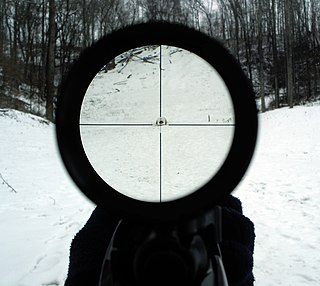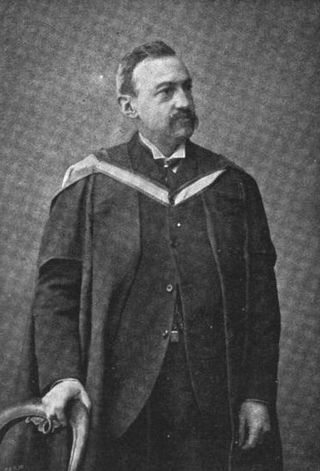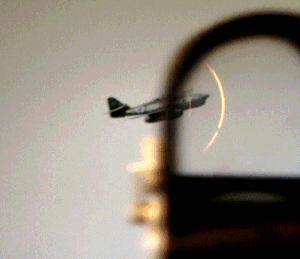
The Advanced Combat Optical Gunsight (ACOG) is a series of prismatic telescopic sights manufactured by Trijicon. The ACOG was originally designed to be used on the M16 rifle and M4 carbine, but Trijicon has also developed ACOG accessories for other firearms. Models provide fixed-power magnification levels from 1.25× to 6×. ACOG reticles are illuminated at night by an internal tritium phosphor. Some versions have an additional daytime reticle illumination via a passive external fiberoptic light pipe or are LED-illuminated using a dry battery. The first ACOG model, known as the TA01, was released in 1987.

A magnifying glass is a convex lens that is used to produce a magnified image of an object. The lens is usually mounted in a frame with a handle. Beyond its primary function of magnification, this simple yet ingenious tool serves a variety of purposes. It can be employed to focus sunlight, harnessing the Sun's rays to create a concentrated hot spot at the lens's focus, which is often used for starting fires.

A reticle, or reticule also known as a graticule, is a pattern of fine lines or markings built into the eyepiece of an optical device such as a telescopic sight, spotting scope, theodolite, optical microscope or the screen of an oscilloscope, to provide measurement references during visual inspections. Today, engraved lines or embedded fibers may be replaced by a digital image superimposed on a screen or eyepiece. Both terms may be used to describe any set of patterns used for aiding visual measurements and calibrations, but in modern use reticle is most commonly used for weapon sights, while graticule is more widely used for non-weapon measuring instruments such as oscilloscope display, astronomic telescopes, microscopes and slides, surveying instruments and other similar devices.

A telescopic sight, commonly called a scope informally, is an optical sighting device based on a refracting telescope. It is equipped with some form of a referencing pattern – known as a reticle – mounted in a focally appropriate position in its optical system to provide an accurate point of aim. Telescopic sights are used with all types of systems that require magnification in addition to reliable visual aiming, as opposed to non-magnifying iron sights, reflector (reflex) sights, holographic sights or laser sights, and are most commonly found on long-barrel firearms, particularly rifles, usually via a scope mount. Similar devices are also found on other platforms such as artillery, tanks and even aircraft. The optical components may be combined with optoelectronics to add night vision or smart device features.

A milliradian is an SI derived unit for angular measurement which is defined as a thousandth of a radian (0.001 radian). Milliradians are used in adjustment of firearm sights by adjusting the angle of the sight compared to the barrel. Milliradians are also used for comparing shot groupings, or to compare the difficulty of hitting different sized shooting targets at different distances. When using a scope with both mrad adjustment and a reticle with mrad markings, the shooter can use the reticle as a ruler to count the number of mrads a shot was off-target, which directly translates to the sight adjustment needed to hit the target with a follow-up shot. Optics with mrad markings in the reticle can also be used to make a range estimation of a known size target, or vice versa, to determine a target size if the distance is known, a practice called "milling".

Raytheon ELCAN Optical Technologies, also simply ELCAN, is a Canadian optics and electronics manufacturing company owned by American defense contractor RTX Corporation, currently based in Midland, Ontario. ELCAN produces optical devices geared towards both civilian and military markets, and their products are sold through Armament Technology Inc. based in Halifax, Nova Scotia, and associated channels of dealers.

A sight or sighting device is any device used to assist in precise visual alignment of weapons, surveying instruments, aircraft equipment, optical illumination equipment or larger optical instruments with the intended target. Sights can be a simple set or system of physical markers that serve as visual references for directly aligning the user's line of sight with the target, or optical instruments that provide an optically enhanced—often magnified—target image aligned in the same focus with an aiming point. There are also sights that actively project an illuminated point of aim onto the target itself so it can be observed by anyone with a direct view, such as laser sights and infrared illuminators on some night vision devices, as well as augmented or even virtual reality-enabled digital cameras with software algorithms that produce digitally enhanced target images.
Aimpoint AB is a Swedish optics company based in Malmö, Sweden that manufactures red dot sights.

A finderscope is an accessory sighting device used in astronomy and stargazing, typically a small auxiliary refracting telescope/monocular mounted parallelly on a larger astronomical telescope along the same line of sight. The finderscope usually has a much smaller magnification than the main telescope, thus providing a larger field of view, useful for manually pointing the main telescope into a roughly correct direction that can easily place a desired astronomical object in view when zooming in. Some finderscopes have sophisticated reticles to more accurately aim the main telescope and/or even perform stadiametric measurements.

EOTECH is an American company that designs, manufactures, and markets electro-optic and night vision products and systems. The company is headquartered in Plymouth, Michigan.

Sir Howard Grubb was an optical designer from Dublin, Ireland. He was head of a family firm that made large optical telescopes, telescope drive controls, and other optical instruments. He is also noted for his work to perfect the periscope and inventing the reflector sight.
A magnifier is a device used for magnification.

The C79 optical sight (SpecterOS3.4x) is a telescopic sight manufactured by Elcan. A variant, the M145 Machine Gun Optic is in use by the US military. It is 3.4×28, meaning 3.4x magnification, and a 28mm diameter objective lens. A tritium illuminated reticle provides for normal and low-light conditions sighting. It can be mounted to a variety of rifles and light machine guns using the Picatinny rail mounting system or the similar Diemaco rail system found on small arms produced by Diemaco/Colt Canada. Similar rifle sights are the Sight Unit Small Arms, Trilux (SUSAT) and the Advanced Combat Optical Gunsight (ACOG).

The PSO-1 is a 4×24 telescopic sight manufactured in Russia by the Novosibirsk instrument-making factory and issued with the Russian military Dragunov sniper rifle. It was introduced on 3 July 1963 together with the Dragunov sniper rifle.

A red dot sight is a common classification for a non-magnifying reflector sight that provides an illuminated red dot to the user as a point of aim. A standard design uses a red light-emitting diode (LED) at the focus of collimating optics, which generates a dot-style illuminated reticle that stays in alignment with the firearm the sight is attached to, regardless of eye position.

A reflector sight or reflex sight is an optical sight that allows the user to look through a partially reflecting glass element and see an illuminated projection of an aiming point or some other image superimposed on the field of view. These sights work on the simple optical principle that anything at the focus of a lens or curved mirror will appear to be sitting in front of the viewer at infinity. Reflector sights employ some form of "reflector" to allow the viewer to see the infinity image and the field of view at the same time, either by bouncing the image created by lens off a slanted glass plate, or by using a mostly clear curved glass reflector that images the reticle while the viewer looks through the reflector. Since the reticle is at infinity it stays in alignment with the device to which the sight is attached regardless of the viewer's eye position, removing most of the parallax and other sighting errors found in simple sighting devices.

A holographic weapon sight or holographic diffraction sight is a non-magnifying gunsight that allows the user to look through a glass optical window and see a holographic reticle image superimposed at a distance on the field of view. The hologram of the reticle is built into the window and is illuminated by a laser diode.

A collimator sight is a type of optical sight that allows the user looking into it to see an illuminated aiming point aligned with the device the sight is attached to, regardless of eye position. They are also referred to as collimating sights or "occluded eye gunsight" (OEG).

A prism sight or prismatic sight, sometimes also called prism scope or prismatic scope, is a type of telescopic sight which uses a reflective prism for its image-erecting system, instead of the series of relay lenses found in traditional telescopic sights. The use of prisms makes it possible to construct a shorter and lighter sight, or with an offset between the eyepiece and objective axes.

The Elcan Specter is a line of multi-role prism sights created by Raytheon ELCAN Optical Technologies originally designed for M16/M4 family of rifles but now also exists for light machine gun and heavy machineguns. Most of the optics are capable of switching between magnifications and illumination.

















